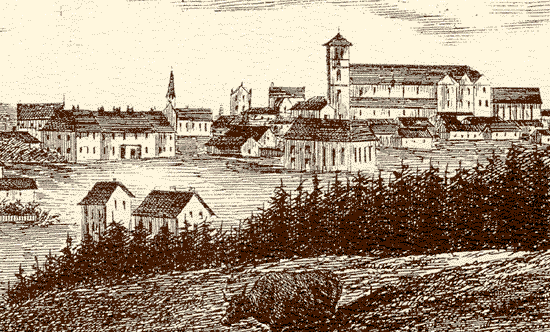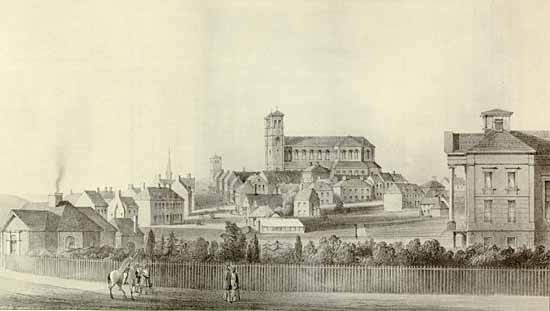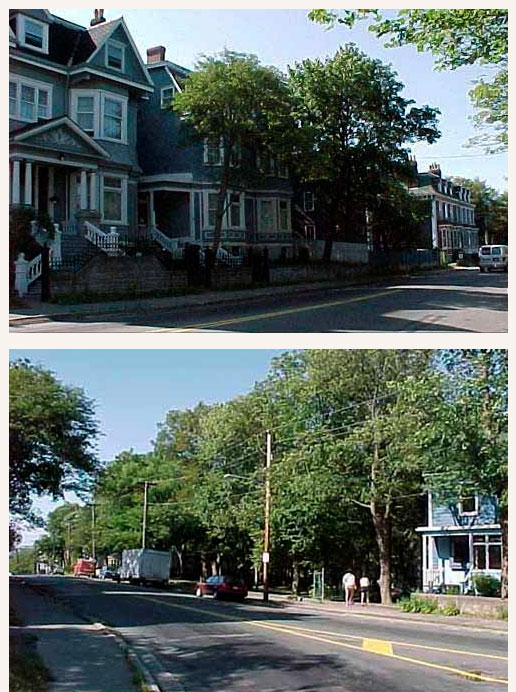Setting and Influence
Setting of the Government House
Government House was built on the edge of town, on the barrens, just east of a bog. No central location within the city was chosen for it - and with good reason. To be anywhere on the edge of the slope above the harbour was to expose the property to the risk of fire, and its inhabitants to the repulsive, if rich, smell of fish drying. In addition, because central properties had fallen into the hands of the merchants, no ground of sufficient scale was available in that area.

But one should not presume that the site of Government House lacked status. It was set essentially at the junction of Kingsbridge and Military Roads, a very short distance from the old Fort William. On Kingsbridge Road was the Commissariat, generally considered the best residence in the town of the time. Below that, going north, was the house of the commander of the Royal Engineers. Kingsbridge Road led out into the countryside, to Quidi Vidi Pond. Unlike Freshwater Road and the road from Riverhead which went to farms, Kingsbridge Road might be seen as a road to less arduous pursuits - to hunting and fishing and boating, or to country houses such as that of the Deputy Ordnance Storekeeper, George Winter, on what is now Winter Avenue. One should also remember that Kingsbridge Road ran into the road to Portugal Cove and to the road to Torbay. Built by Cochrane, the road to Portugal Cove was important because it was the connection to Conception Bay and its important ports, and represents the beginnings of our highway system.
Directly across the road, between the head of Gower Street and what is now Cochrane Street, a group of houses were put up in the early 1830s called Cochrane Place. There E.M. Archibald, the governor's secretary and later the Attorney General, lived. In 1836 St. Thomas' Church was built on the corner lot and became the fashionable church of the town. In the 1840s more substantial houses were built along Military Road and down Cochrane Street on the Stripling and Tobin estates. On Kingsbridge, Archibald built himself a substantial brick house in 1841 and the Thomas brothers built their superb Classical Revival Devon Place in 1844. Down Rennies Mill Road the houses of professional people began to appear. The upper end of the line - and of the fashionable East End - was determined by the monumental Roman Catholic Cathedral underway from 1841 to 1855. And, when the Colonial Building was built in 1849, the character of the entire area was firmly established.

Influence of the Government House on St. John's
When the town began to expand again in the late 1870s and into the 1880s, an important development took place along Rennies Mill Road. Here several major builders constructed a number of large houses in the fashionable Second Empire style. These houses marked the solidification of an upper-class suburb around Government House. The presence of Government House as well as the public park (for which the Governor had given land) was a major factor in this development. The next major bout of mansion-building occurred from 1905 to 1914 during which a series of very large, elaborately finished Queen Anne style houses were built down Rennies Mill Road, along Circular and up Kingsbridge. As a result these buildings formed a residential square around Government House. In this area one finds the finest examples of two important architectural styles and the homes of Newfoundland's political, cultural and economic elite. In the social and architectural development of the area, as well as in the shaping of the townscape, Government House represented a critical factor.

It can also be argued that the process of building Government House also affected the building of St. John's. During its construction it was the major building underway in Newfoundland; indeed, nothing of its size or quality was built (churches excepted) until after the Great Fire of 1892. It required 28 skilled masons, 25 carpenters and related tradespeople who had to be imported from Scotland. It is not clear how many of these craftsmen stayed once their work was done but certainly some of the principals did. The Clerk of the Works, William Haddon stayed in the town until after the 1846 Fire, and one his sons became an architect. Denis Hannigan, a mason for the Royal Engineers, also remained in Newfoundland. Patrick Kough, a local contractor who built the Court House in Harbour Grace and the Colonial Building among other works, was also involved in the construction of Government House. It is likely that a portion of the craftsmen and tradesmen stayed to put up or design other buildings or to train other people.
Government House should then be seen not only as an historic monument or an important building, but also as an influence on the broader development of the town of St. John's. Its building was confirmation of the permanence of Newfoundland, that it was no longer merely a fishery station. It had a marked effect on the East End of St. John's, determining much of its character and, by extension, its architecture and townscape. And it had a more general effect on the process of building and the building trades in the town.




